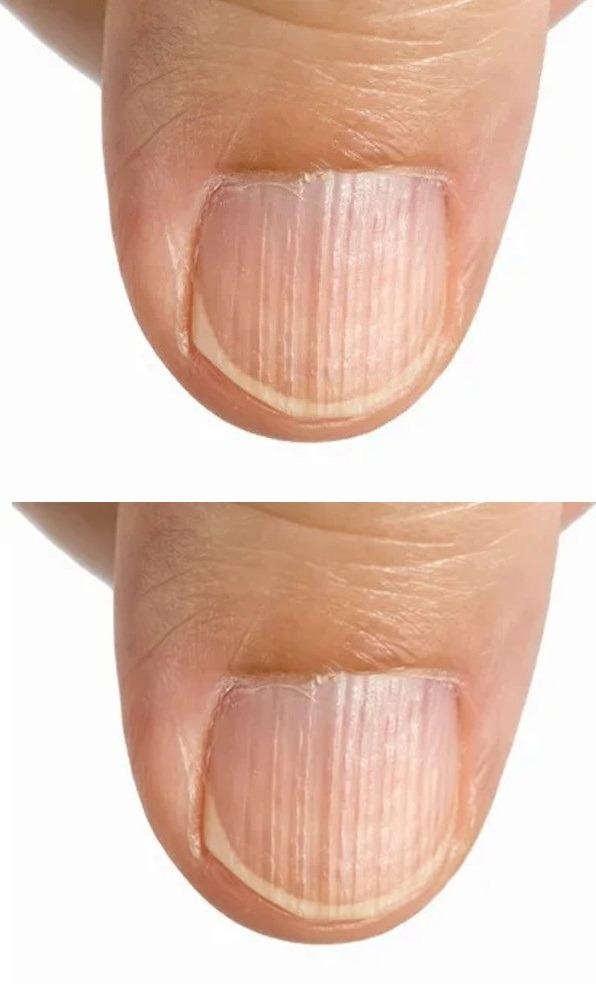ADVERTISEMENT
Horizontal ridges, known as Beau’s lines, run across the nail and can be more pronounced or noticeable compared to vertical ridges. They can appear as deep indentations or shallow lines across the nail plate.
Possible Causes:
Infections or Illness: Severe illnesses or infections, including high fever or viral infections like chickenpox or measles, can lead to Beau’s lines as the body temporarily stops nail growth.
Trauma or Injury: Physical injury to the nail, such as trauma to the finger or hand, can cause temporary interruption of nail growth, resulting in horizontal ridges.
Nutrient Deficiencies: Deficiencies in zinc, protein, or biotin can disrupt nail growth, leading to the appearance of Beau’s lines.
Systemic Conditions: Conditions like diabetes, heart disease, thyroid disorders, and malnutrition may be associated with horizontal ridges.
Chemotherapy: Cancer treatments, particularly chemotherapy, can interrupt the growth of nails, causing ridges to form as a side effect.
When to See a Doctor:
If you develop Beau’s lines and they are accompanied by other symptoms like unexplained weight loss, fatigue, or swelling, it’s important to consult a doctor. This could point to an underlying systemic issue that needs attention.
3. Pitting (Small Dents or Holes) on Nails
What It Is:
Pitting refers to small, shallow indentations or depressions that appear on the surface of the nails. It’s more commonly associated with certain skin conditions.
Possible Causes:
Psoriasis: Pitting is a common sign of psoriasis, a chronic autoimmune condition that affects the skin but can also impact nails. The condition may lead to small pits forming in the nails.
Eczema: Another skin condition that can lead to pitting, as eczema can affect the nail matrix (the part of the nail where growth occurs).
Arthritis: Certain types of arthritis, particularly psoriatic arthritis, can also cause pitting in the nails.
When to See a Doctor:
If you notice pitting along with other skin symptoms (like rashes or joint pain), it’s a good idea to see a dermatologist or rheumatologist, as it could be a sign of an autoimmune condition.
4. Ridges Caused by Stress or Illness
What They Are:
Temporary ridges, especially horizontal ones, can form as a response to severe stress, illness, or trauma. These lines may appear after a period of high stress or a significant health event, like surgery or an accident.
Possible Causes:
Stress or Fever: A significant physical or emotional stressor, such as illness or surgery, may temporarily halt the nail’s normal growth, leading to the appearance of ridges.
Chronic Illness: Conditions that cause chronic stress on the body, like autoimmune diseases or heart disease, may affect the growth of nails, leading to visible ridges.
When to See a Doctor:
If your ridges are associated with recent illness, stress, or other symptoms like unexplained weight changes or fatigue, it’s worth discussing with your healthcare provider to rule out underlying conditions.
5. Ridges Due to Dehydration
What It Is:
Lack of hydration can make nails dry and brittle, leading to the formation of ridges.
Possible Causes:
Dehydration: Not drinking enough water or not moisturizing the nails properly can lead to dryness and the formation of ridges.
Excessive Use of Nail Products: Frequent use of nail polish remover, especially those containing harsh chemicals, can dry out the nails and cause ridges.
When to See a Doctor:
If dehydration is suspected to be the cause of the ridges, improving your hydration levels and moisturizing your nails might help. If the ridges persist despite these changes, consult with a healthcare provider.
In Conclusion:
Ridges on your nails are typically harmless, especially if they appear as you age. However, if the ridges are new, severe, or accompanied by other symptoms, it could signal an underlying health issue that requires attention. If you’re concerned about the appearance of your nails or if there are any changes in the way your nails look or feel, it’s best to seek medical advice from a healthcare provider.
